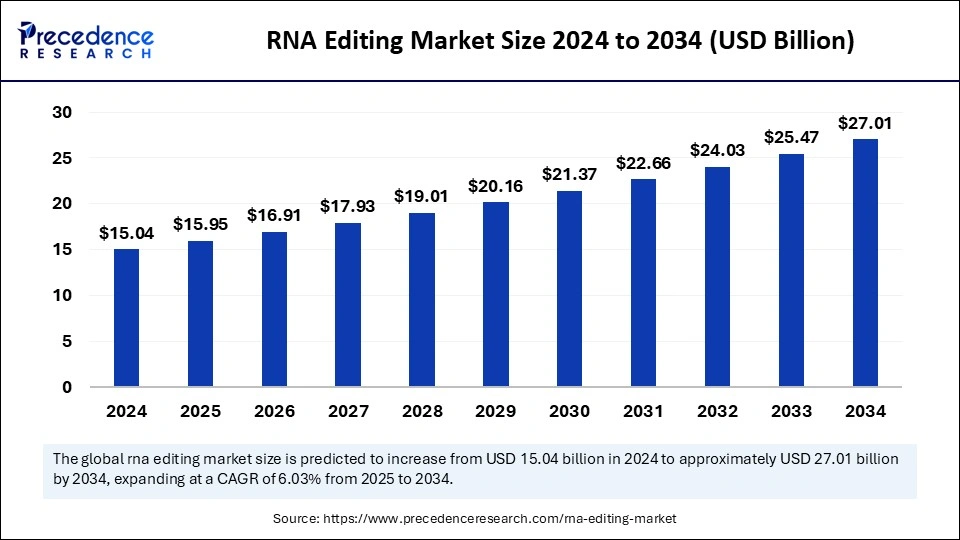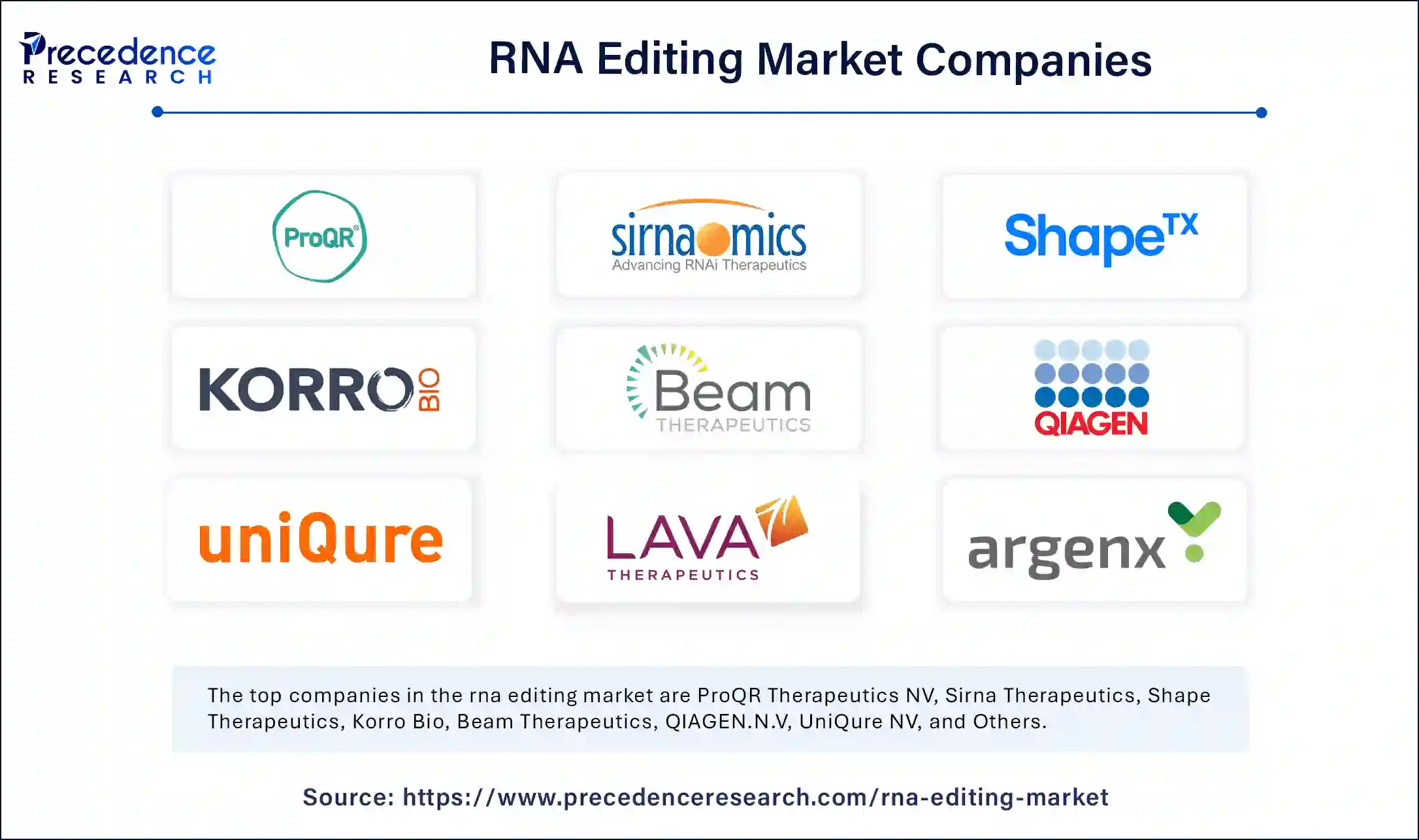February 2025
The global RNA editing market size is calculated at USD 15.95 billion in 2025 and is forecasted to reach around USD 27.01 billion by 2034, accelerating at a CAGR of 6.03% from 2025 to 2034. The market sizing and forecasts are revenue-based (USD Million/Billion), with 2024 as the base year.
The global RNA editing market size was estimated at USD 15.04 billion in 2024 and is predicted to increase from USD 15.95 billion in 2025 to approximately USD 27.01 billion by 2034, expanding at a CAGR of 6.03% from 2025 to 2034. The demand for RNA editing is increasing due to its increasing use in drug development, which can help develop enhanced therapies.

The emergence of artificial intelligence and machine learning (ML) are playing a transformative role in the healthcare industry. The base of AI relies on data analysis, and these algorithms are widely used to identify RNA editing sites. The role of these technologies becomes critical in the guidance of optimal editing targets, where companies are investing heavily in innovation in new healthcare solutions. The use of Machine Learning is also increasing in the optimization of RNA enzymes to attract more specific targets throughout the process. Additionally, the implementation of AI in drug discovery is helping in these procedures by making several contributions, like predictive modeling, which can save additional time and effort.
RNA editing, also referred to as RNA modification, is the post-transcriptional molecular process that changes the sequence of an RNA molecule. This is widely used in various biological processes like gene regulation, protein diversity, and many others. The RNA editing market is growing rapidly due to the growth in therapeutics and gene therapies that use these elements for modification without the requirement for altering DNA. The expansion relies upon the regulation of gene expression that controls the translation of mRNA. The rising demand also increases due to the expansion of various solutions like substitution cytosine-to-uracil and many more.
| Report Coverage | Details |
| Market Size by 2034 | USD 27.01 Billion |
| Market Size in 2025 | USD 15.95 Billion |
| Market Size in 2024 | USD 15.04 Billion |
| Market Growth Rate from 2025 to 2034 | CAGR of 6.03% |
| Dominated Region | North America |
| Fastest Growing Market | Asia Pacific |
| Base Year | 2024 |
| Forecast Period | 2025 to 2034 |
| Segments Covered | Type, Application, Technique, and Regions |
| Regions Covered | North America, Europe, Asia-Pacific, Latin America, and Middle East & Africa |
Increasing R&D in genetic therapies
The rising incidence of genetic disorders has raised the demand for advanced and precision medicines that can target genetic modifications without altering DNA sequences. The RNA editing market is growing efficiently due to the rising focus of healthcare institutions that aim to cure diseases like genetic disorders, cancer, and others. Continuous R&D initiatives are marking significant advancements in various fields, such as CRISPR-RNA and ADAR-based editing. The use of RNA in these treatments is growing significantly due to the effective results without the need for DNA altering.
Growing focus on drug discovery
The use of RNA is significantly increasing in various applications, which help to target specific genes in the genes that can help to aim new drug discovery. The pharmaceutical companies are significantly contributing by conducting several clinical trials, which boosts the opportunities for new drugs in the market. The RNA editing market is growing rapidly due to the enhancements in small molecule functions that help find key protein interactions. The constant initiatives by the companies are anticipated to reduce drug failures, which will help boost the expansion of targeted therapies with a specialized approach.
The rise of RNA editing is highly attributed to the technologies heavily used in research and development activities. The RNA editing market has witnessed significant demand in developed countries due to the availability of healthcare infrastructure. These procedures require advanced technologies that cannot be affordable for underdeveloped countries and tend to hamper market growth. Additionally, the shortage of skilled workforce has become a concern in these regions due to limited financial availability. The rising focus on healthcare also tends to increase the regulatory standards.
Growth in personalized medicine
The demand for effective and convenient solutions has been a major trend that is leading to several changes in the healthcare sector. The RNA editing market is growing rapidly due to technological advancements that help innovate personalized medicines according to the patient's individual genetic profile and medical history. This helps in increasing the therapy outcomes with a more effective approach. The adoption of RNA editing is playing a crucial role in tackling cancer disorders with a more specific approach to the disease. The rapid advancements in personalized medicines are anticipated to increase the safety of these treatments.
The changing lifestyle patterns are one of the major factors which have led to the increasing disorders. This has attracted significant attention from the governments to focus on the advancements of their healthcare infrastructure. The RNA editing market is one of the fastest growing due to the rising government investments in genetic and RNA therapies. Public-private partnerships are enhancing these efforts due to the support of various government agencies, educational institutions, and many more.
The messenger RNA modification segment marked its dominance over the market by registering the highest share in 2024. The mRNA modification focuses on carrying genetic instructions from DNA to ribosomes. The RNA editing market is growing rapidly due to its increasing role in gene expression, vaccines, and many other applications. The growing adoption of these therapeutics is driving more investments in the fight against various diseases like cancer immunotherapy and other infectious diseases. The industry is anticipated to excel rapidly due to the increasing commercialization of these drugs.
The transfer RNA modification segment is anticipated to grow at the highest CAGR during the forecast period of 2025 to 2034. The tRNA modification deals with the translation of mRNA codons into amino acids. The increasing R&D activities are proving the use of tRNA in various therapeutics to target stress response, metabolism, and many more. This is leading to the development of tRNA drugs, which will drive more growth in the coming years. The advancements are also anticipated to enhance stability and accuracy through thiolation, deamination, and methylation. Additionally, the rapid growth in epi transcriptomics is anticipated to expand the use of tRNA modification in the upcoming years.
The deamination segment generated the highest market share in 2024. The technique uses adenosine-to-inosine or cytosine-to-uracil modifications, which influence immune response regulation. The dominance of the segment is attributed to the increasing use of the technique in drug discovery. Additionally, the rising cancer prevalence also contributes to the growth of the RNA editing market, where deamination plays a key role. The rising demand is leading to several investments in research, which will boost the advancements in these therapies.
The insertion/deletion segment is anticipated to grow at the highest CAGR during the forecast period of 2025 to 2034. The techniques are used to add or remove nucleotides in RNA sequences. The market is growing significantly due to the various benefits of this technique, which differ from deamination, which helps in the direct correction of genetic errors. These factors increase its reliability in curing various rare disorders.
The cancer segment stood the dominant in the global market in 2024. The rising prevalence of cancer is one of the major factors driving the growth of the RNA editing market. The NIH data also states that cancer incidence in India is anticipated to grow from 1.46 million in 2022 to 1.57 million in 2025. The role of RNA editing stands out as crucial because it modifies immune response pathways, oncogenes, and many more with the use of various techniques in cancer therapy. The rising investments from pharmaceutical companies in oncology are anticipated to play a crucial role as the market is witnessing a rapid shift towards RNA-based cancer therapies.
The genetic disorders segment is anticipated to grow at the fastest rate during the forecast period of 2025 to 2034. The changing patient preferences towards personalized medicines are anticipated to be one of the crucial players that boost the growth of the market. The increasing number of clinical trials is one of the major factors that will improve these therapies and will stand out as a safer alternative to DNA-based editing. The rising prevalence of rare diseases is anticipated to attract more investments in drug discovery with the use of RNA editing.
North America dominated the global RNA editing market by registering the highest share in 2024. The growth of the region is attributed to the advanced healthcare and research infrastructure in countries like the United States and Canada. The presence of NIH, Harvard, and many other major institutions helps advance drug development. The rising cancer prevalence also attracts several investments from governments, which help to innovate new therapies for patients. The presence of pharmaceutical companies in the region is also anticipated to boost the commercialization in these countries.
Asia Pacific is anticipated to grow at the highest CAGR in the market during the forecast period of 2025 to 2034. The growth of the region is attributed to the development of genomic medicine in countries like South Korea, Japan, and China. These governments are contributing significantly through various initiatives like Biotech Funding Programs in Japan and many more. The rising focus on tackling rare disorders will drive more investments in the upcoming years.

By Type
By Technique
By Application
By Regions
For inquiries regarding discounts, bulk purchases, or customization requests, please contact us at sales@precedenceresearch.com
No cookie-cutter, only authentic analysis – take the 1st step to become a Precedence Research client
February 2025
February 2025
March 2025